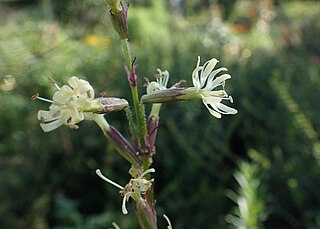
Silene is a genus of flowering plants in the family Caryophyllaceae. Containing nearly 900 species, it is the largest genus in the family. Common names include campion and catchfly. Many Silene species are widely distributed, particularly in the northern hemisphere.

A wildflower is a flower that grows in the wild, meaning it was not intentionally seeded or planted. The term implies that the plant probably is neither a hybrid nor a selected cultivar that is in any way different from the way it appears in the wild as a native plant, even if it is growing where it would not naturally. The term can refer to the flowering plant as a whole, even when not in bloom, and not just the flower.

Silene flos-cuculi, commonly called ragged-robin, is a perennial herbaceous plant in the family Caryophyllaceae. This species is native to Europe and Asia, where it is found along roads and in wet meadows and pastures. In Britain it has declined in numbers because of modern farming techniques and draining of wet-lands and is no longer common. However, it has become naturalized in parts of the northern United States and eastern Canada.

Silene latifolia subsp. alba, the white campion is a dioecious flowering plant in the family Caryophyllaceae, native to most of Europe, Western Asia and Northern Africa. It is a herbaceous annual, occasionally biennial or a short-lived perennial plant, growing to between 40–80 centimetres tall. It is also known in the US as bladder campion but should not be confused with Silene vulgaris, which is more generally called bladder campion.

Silene dioica, known as red campion and red catchfly, is a herbaceous flowering plant in the family Caryophyllaceae, native throughout central, western and northern Europe, and locally in southern Europe. It has been introduced in Iceland, Canada, the US, and Argentina.

Silene undulata is a plant native to the Eastern Cape of South Africa.

Grevillea involucrata, also known as Lake Varley grevillea, is a low-growing shrub which is endemic to the south-west of Western Australia. It grows up to 0.5 metres in height and produces pink flowers between June and October in its native range.

Asperula involucrata is a species of flowering plant in the family Rubiaceae.

Silene flavescens are flowering plants part of the genus Silene, family Caryophyllaceae. They are widely distributed and are found in the northern hemisphere. They are native to Hungary and the Balkan Peninsula. It is an herbaceous species belonging to the tribe Sileneae

Silene otites, called Spanish catchfly, is a species of flowering plant in the genus Silene, native to Europe and the Transcaucasus area, and introduced to Xinjiang in China. It varies its floral odors to attract mosquitoes and moths at night and flies and bees by day. It is dioecious, with separate male and female plants.

Silene wahlbergella is a species of flowering plant belonging to the family Caryophyllaceae.
Silene chlorantha is a species of flowering plant belonging to the family Caryophyllaceae.

Silene tatarica, called the Tartarian catchfly, is a species of flowering plant in the genus Silene, found in north-central Europe and western Asia, from Germany and Norway eastwards to western Siberia and Kazakhstan. A specialist of riparian habitats, its seeds are dispersed by water.

Silene indica, the Indian campion, is a species of flowering plant in the family Caryophyllaceae, native to northern Pakistan, the Himalayas, and southern Tibet. It typically grows at elevations of 2,300 to 3,900 m.
Silene tibetica is a species of plant which is a member of the family Caryophyllaceae. The species can be found in Tibet.

Silene keiskei is a species of flowering plant in the family Caryophyllaceae. The species is native to Japan (Honshu).

Silene mandonii is a species of flowering plant in the family Caryophyllaceae.

Silene supina is a species of flowering plant in the family Caryophyllaceae.

Silene rubella is a species of flowering plant in the family Caryophyllaceae. In Italy the species goes by the common name silene rosseggiante.

Silene aegyptiaca is a species of flowering plant in the family Caryophyllaceae. The common name for this species is Egyptian campion or Egyptian catchfly.


















